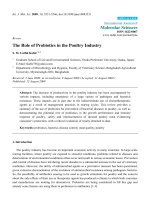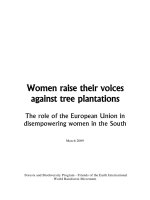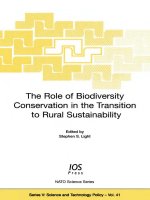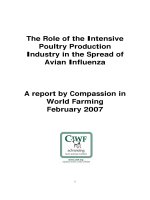Perceived social attitude towards the role of women in peri urban dairy farming in costal belt of Odisha, India
Bạn đang xem bản rút gọn của tài liệu. Xem và tải ngay bản đầy đủ của tài liệu tại đây (230.07 KB, 8 trang )
Int.J.Curr.Microbiol.App.Sci (2020) 9(3): 3173-3180
International Journal of Current Microbiology and Applied Sciences
ISSN: 2319-7706 Volume 9 Number 3 (2020)
Journal homepage:
Original Research Article
/>
Perceived Social Attitude towards the Role of Women in Peri Urban Dairy
Farming in Costal Belt of Odisha, India
B. Sahoo*, Anil Kumar, A. K. Panda, Lipi Das, U. R. Maradana,
D. N. Sarangi and S. K. Srivastava
ICAR - Central Institute for Women in Agriculture, Bhubaneswar-751003, India
*Corresponding author
ABSTRACT
Keywords
dairy farming
natural resources
the constraints
Article Info
Accepted:
25 February 2020
Available Online:
10 March 2020
Role of women in Peri urban dairy farming was studied with respect to access and
control over resources and services and constraints faced by them by collecting
data from 60 respondents in Cuttack and Jagatsinghpur districts of Odisha. The
results indicated that the access and control over natural resources by men were
higher for cultivable land and grazing resources whereas livestock was mostly
under the joint control of men and women. Women had more access to intra house
relation (45.0%) and self-help groups (56.7%) whereas men have more access to
banking services (51.7%), participation in meetings (43.3%), management of
labour(36.7%) and management of revenue earned (41.7%). More joint control
over participation of meetings (38.3%) indicates the importance of the gender
equity in the growing dairy sectors of Odisha. Among the constraints, access to
technologies (98.3%) was found to be the major limitation followed by resources
(88.3%) and infrastructure (75%). A higher joint access and control over
technology and communication reflected relatively gender equity in the society
showing the path of progress in peri urban dairy farming.
Introduction
Dairy farming in India is a female dominated
enterprise. About 75 million women as
against 15 million men engage in dairying in
India (Thakur and Chandar, 2006). Peri urban
dairy farming offers employment and cash
flow on a daily basis to the farm women and
improve their livelihoods. In this system,
intensification of livestock activities through
modification of traditional practices and
increasing external input is widely advocated
to achieve higher household income of the
livestock keepers.
Most of the dairy units were usually located
in peri-urban or urban areas and markets for
selling milk and easily accessible offering
employment options to a large number of
people especially women. However, lack of
awareness and adoption of scientific
management practices in post-harvest milk
3173
Int.J.Curr.Microbiol.App.Sci (2020) 9(3): 3173-3180
production technologies, gender asymmetries
like access to market, income generated from
sale of milk and milk products processing
technologies and interventions, veterinary
services, participation in dairy developmental
programmes and policies are the major
constraints for upliftment of farm women in
peri-urban dairy farming.
Despite considerable involvement and
contribution in animal husbandry, significant
gender inequalities exist in access to
technologies, credit, information, inputs and
services probably because of inequities in
ownership of productive assets in dairy sector.
Women face greater constraints than men in
accessing natural resources, extension
services, marketing opportunities and
financial services as well as in exercising their
decision-making power. These constraints
often prevent women from reaching their full
potential and therefore compromise the
achievement of overall household food
security and income generation.
Most of the dairy units located in peri-urban
or urban areas especially in Odisha supply
fresh milk in the vicinity of cities which has
huge demand for fresh milk. The farm
women/milk producer work hard but the
incentives received by them through dairy
farming is very less. Information on the role
of women, functioning and status of the dairy
farming in peri-urban areas of Odisha is not
well understood and study on existing
characteristics and gender involvement in peri
urban dairy farming is required for improving
livelihood support of farm women. This study
in two peri-urban zones of Cuttack and
Jagatsinghpur districts of Odisha was
undertaken to ascertain basic facts about the
perceived attitude towards role of women in
peri urban dairy farming, socio economic
status of women and methods of animal
management which could establish the ground
for possible ways of improvement in dairy
farming, animal health and welfare of women.
Materials and Methods
The present investigation studied the access
and control over different resources and
constraints faced by women in Cuttack and
Jagatsinghpur districts of Odisha. Primary
data related to number of milch cows owned,
production of milk per day, constraints faced,
and participation of men and women related
to different activities were collected by
personal interview method. A total of 60
respondents were selected randomly from
both the districts. Data was also collected
related to available natural resources, feeds,
health care, maintenance, processing and
marketing of milk and appropriate statistical
tools were used to analyze the data.
Results and Discussion
Men and women differ in the types of rights
they have which also holds good in case of
dairy farming. Women also differ from men
in their preferences for dairying vis-à-vis
other assets. Women could not buy livestock
because income from both livestock and crop
agriculture, including their vegetable plots,
were controlled by men (Chawatama et al.,
2005).This concurs with more widespread
evidence on the importance to women of
informal mechanisms for obtaining livestock
assets.
Even though in cases where livestock assets
are owned by women, their lack of access to
complementary assets and services for
livestock health, production and marketing,
and commercialization, particularly of milk
and dairy enterprises may leads to low
income. Reducing these threats may help in
securing livestock assets a viable pathway out
of poverty for women. In the present study,
characterization of socio-economic status of
farmers in dairy farming revealed that
3174
Int.J.Curr.Microbiol.App.Sci (2020) 9(3): 3173-3180
population density, sex ratio and literacy level
in Jagatsinghpur is more than Cuttack (Table
1). However, dairy animals especially cows
and buffaloes are more in Cuttack and rearing
of cows per household in Jagatsinghpur is
more than Cuttack. Animals per household
rearing level in both the districts was higher
than the average level of Odisha and India
reflecting the advancement in dairy farming
in both the districts of Odisha.
Despite crucial contribution to livestock
sector and food security, women’s access to
and control over natural resources remains
lower than men. Access of men for natural
resources is higher in cultivable land (51.7%)
and grazing resources (41.7%) while the joint
access is more for livestock (41.3%) and
water resources (41.7%) (Table 2). Although,
the control over cultivable land (45%),
grazing resources (40%) is mostly the domain
of men, livestock as an asset was mostly
under the joint control (41.7%). In consistent
with the present findings, access to green
fodder throughout the year was found to be
less being 57.14% in marginal farmers and
52.38% in landless labourers (Garg et al.,
2005; Kumar et al., 2006; Kaushal et al.,
2012). The availability of green fodder is
necessary to feed the milch animals in order
to obtain higher milk production Thus, there
is need to educate the farmers about the
nutritional significance of fodders so that they
could grow it round the year. Further,
increasing the grazing area and quality of the
herbage especially the leguminous fodder
through converting the waste land of the
village in to pasture land in coastal belt of
Odisha could contribute a lot to far.
The access (%) over financial assets
especially liquid assets, credit, capital, income
and critical input which is mostly in the
domain of men (50, 41.7, 41.7, 50 and 51.7)
(Table 3). The lower level of access and
control over financial assets by the women
leads to lack of decision making which is a
major limitation for women empowerment.
Rural women perceived control over the
activities of getting loans/credits from the
banks as the responsibility of men showing
very low level of participation by women
(21.7%). In contrast, to present findings,
49.2% of women were found to be involved
in this activity in south India (Devaki,
1999).The low participation in the study area
reflects awareness and capacity building
needs to be developed for farm women
involved in dairy farming in Odisha.
The access (%) over physical assets showed
that men have higher access on means of
transport, communication, marketing and
health care (50, 40, 51.7 and 40). Sociocultural barriers continue to hinder women’s
access to animal health services at community
level. However, more joint access over house
(38.3%) and technology (45%) reflected
gender equity in the society showing the path
of progress in peri urban dairy farming.
Similarly, men showed to have more control
(%) over transport, marketing and health care
(53.3, 58.3 and 41.7) where as women have
more control over house asset (48.3%) and
joint control over communication (55%).
The access over human assets indicates that
women have more access (40%) to local
knowledge which is more than men. Whereas
men have more access (%) to education,
training and skill up gradation, information,
extension functionaries, hired labour (46.7,
50, 50, 45 and 46.7) as compared to women
(Table 5). However, women have more access
on family labour (40%).Similar trend was also
followed in control over human assets.
Women provide more labour in dairy
enterprises than men, but the level of
women’s control of the dairy income does not
commensurate with their contribution. There
may be more awareness on importance of
gender in market-related livestock projects.
3175
Int.J.Curr.Microbiol.App.Sci (2020) 9(3): 3173-3180
Similar to the present findings a majority of
the dairy respondents (51.67%) residing in the
peri urban areas had medium level of
management knowledge followed by 31.67%
low and 16.66% high level of knowledge on
dairy farming (Ahirwar et al., 2016). The
women have more access to intra house
relation (45%) and self help groups (SHG)
(56.7%) whereas men have more access to
banking services (51.7%), participation in
meetings (43.3%), management of labour
(36.7%) and management of revenue earned
(41.7%) (Table 6).
Table.1 Socio-economic Status of farmer and dairy scenario of study area
Attributes
Cuttack
Jagatsingpur
Odisha
India
2.6
1.14
41.9
1210.7
Total person(m)
1.4
0.58
21.2
623.2
Male population (m)
1.3
0.56
20.8
587.5
Female population(m)
667
682
270
382
Density
940
968
979
943
Sex ratio
85.5
86.6
72.9
73.0
Total literacy (%)
91.1
92.4
81.6
80.9
Male literacy (%)
79.6
80.6
64.0
64.6
Female literacy (%)
11.6
11.8
17.6
16.2
Gender gap in literacy (%)
Livestock population
534.6
296.9
116.2
190902.4
Cattle (,000)
22.5
11.2
72.6
108702.1
Buffalo (,000)
Livestock density (no/sq km)
136.0
178.0
74.6
60.3
Cattle
5.7
6.7
4.7
34.3
Buffaloes
Percent households rearing livestock
35.6
46.9
39.1
25.9
cattle_H
0.6
0.4
1.8
15.7
Buffaloes_H
Number of livestock species per 1000 human being
204
261
277
158
Cattle
9
10
17
90
Buffaloes
Table.2 Access and control over natural resources by respondents in peri-urban dairy farming
Natural resources
Attributes
Cultivable land
Livestock
Grazing resources
Water resources
Men
31
(51.7)
23
(38.3)
25
(41.7)
15
(25)
Access
Women
15
(25)
12
(20)
15
(25)
20
(33.3)
Joint
14
(23.3)
25
(41.7)
20
(33.3)
25
(41.7)
(Figures in parenthesis indicates percentage)
3176
Men
27
(45)
20
(33.3)
24
(40)
16
(26.7)
Control
Women
14
(23.3)
15
(25)
12
(20)
22
(36.7)
Joint
19
(31.7)
25
(41.7)
24
(40)
22
(36.7)
Int.J.Curr.Microbiol.App.Sci (2020) 9(3): 3173-3180
Table.3 Access and control over financial assets by respondent in peri-urban dairy farming
Financial Assets
Attributes
Liquid assets (money)
Men
30
(50)
Access
Women
15
(25)
Joint
15
(25)
Credit/loan
25
(41.7)
17
(28.3)
Capital
25
(41.7)
Income
Critical Inputs
Men
22
(36.7)
Control
Women
18
(30)
Joint
20
(33.3)
18
(30)
29
(48.3)
13
(21.7)
18
(30)
18
(30)
17
(28.3)
18
(30)
25
(41.7)
17
(28.3)
30
(50)
20
(33.3)
10
(16.7)
22
(36.7)
28
(46.7)
10
(16.7)
25
(41.7)
21
(35)
14
(23.3)
27
(45)
19
(31.7)
14
(23.3)
(Figures in parenthesis indicates percentage)
Table.4 Access and control over physical assets by respondent in peri-urban dairy farming
Physical Assets.
Attributes
Transport
Men
30
(50)
Access
Women
14
(23.3)
Joint
16
(26.7)
Technology
20
(33.3)
13
(21.7)
House
17
(28.3)
Communication
Market
Health Centre
Men
32
(53.3)
Control
Women
19
(31.7)
Joint
9
(15)
27
(45)
21
(35)
15
(25)
24
(40)
20
(33.3)
23
(38.3)
13
(21.7)
29
(48.3)
18
(30)
24
(40)
14
(23.3)
22
(36.7)
15
(25)
12
(20)
33
(55)
31
(51.7)
14
(23.3)
15
(25)
35
(58.3)
11
(18.3)
14
(23.3)
24
(40)
15
(25)
21
(35)
25
(41.7)
14
(23.3)
21
(35)
(Figures in parenthesis indicates percentage)
3177
Int.J.Curr.Microbiol.App.Sci (2020) 9(3): 3173-3180
Table.5 Access and control over human assets by respondent in peri-urban dairy farming
Human assets
Attributes
Local knowledge
Men
20
(33.3)
Access
Women
24
(40)
Men
21
(35)
Control
Women
24
(40)
Joint
16
(26.7)
Joint
15
(25)
28
(46.7)
16
(26.7)
16
(26.7)
21
(35)
20
(33.3)
19
(31.7)
30
(50)
15
(18.3)
15
(31.7)
28
(46.7)
19
(31.7)
13
(21.7)
Access to information
30
(50)
20
(33.3)
10
(16.7)
29
(48.3)
20
(33.3)
11
(18.3)
Access to extension
functionaries
27
(45)
15
(25)
18
(30)
30
(50)
18
(30)
12
(20)
Family labour
10
(16.7)
24
(40)
26
(43.3)
14
(23.3)
26
(43.3)
20
(33.3)
Hired labour
28
(46.7)
17
(28.3)
15
(25)
30
(50)
15
(25)
15
(25)
Formal education
Training and skill up
gradation
(Figures in parenthesis indicates percentage)
Table.6 Access and control over social assets by respondent in peri-urban dairy farming
Social Assets
Men
14
(23.3)
Access
Women
27
(45)
Men
12
(20)
Control
Women
27
(45)
Joint
19
(31.7)
Joint
21
(35)
Members community:
GP/NGO/SHG
20
(33.3)
30
(50)
10
(16.7)
24
(40)
29
(48.3)
7
(11.7)
Access to institutions:
Banks/Research institutes
31
(51.7)
14
(23.3)
15
(25)
27
(45)
15
(25)
18
(30)
Participation in meetings
26
(43.3)
17
(28.3)
17
(28.3)
22
(36.7)
15
(25)
23
(38.3)
Management of labour
22
(36.7)
18
(30)
20
(33.3)
25
(41.7)
18
(30)
17
(28.3)
Management of revenue earned
25
(41.7)
20
(33.3)
15
(25)
23
(38.3)
15
(25)
22
(36.7)
Intra house relation
(Figures in parenthesis indicates percentage)
3178
Int.J.Curr.Microbiol.App.Sci (2020) 9(3): 3173-3180
Table.7 Constraints faced by respondents in peri-urban dairy farming
Constraints
Resources
Technology
Financial
Infrastructure
Marketing
Environment
Yes
53(88.3)
59(98.3)
30(50.0)
45(75.0)
42(70.0)
35(58.3)
No
7(11.7)
1(1.7)
30(50.0)
15(25.0)
18(30.0)
25(41.7)
(Figures in parenthesis indicates percentage)
Similarly, women had higher control over
intra house relation (45%) and SHG (48.3%).
More joint control over participation of
meetings (38.3%) indicates the importance of
the gender equity in the growing dairy sectors
of Odisha. The respondents faced constraints
in different aspects like resources, technology,
financial, infrastructure, marketing and
environment (Table 7). Access over
technologies (98.3%) was found to be a major
limitation followed by resources (88.3%) and
infrastructure (75%).
Similar to present findings, 50 to 75 % urban
milk producers lack proper marketing
facilities
and
skill
based
capacity
development programmes through need-based
and well-tailored training programmers
suitable for farm women would in turn help
them to have more contacts with extension
agencies (Sowjanya and Halakatti, 2015).
Peri-urban dairy farming is mostly practised
to meet the demand for fresh milk in the study
area revealed that the access and control over
different resources and services of men is
much higher than women. However, women
have more access over local knowledge,
family labour, intra house relations and selfhelp groups whereas more control of women
over capital, income, house property
contributed by men shows developing owning
of income by women. Farm women have
more power and confidence to grow through
dairy farming in entrepreneurship mode for
higher income through self-help groups and
cooperatives. Apart from that the access to
green fodder round the year was very less and
the availability of green fodder, converting
grazing area and quality pasture land should
be prioritized to augment milk production.
There is also a need to increase the training
and demonstration of technologies for farm
women to have more power and confidence to
grow
through
dairy
farming
in
entrepreneurship mode for higher income.
Despite having constrained by a number of
factors, dairying in urban and peri urban areas
would create employment opportunities
leading to women empowerment.
References
Ahirwar, M.K., Singh, H.S., Patel, R.K. and
Mondal, M.K. 2016. Socio-Personal and
Economic Profile of Peri-Urban and
rural dairy farmers in Rewa district of
Madhya Pradesh. Int. J. Agri.
Sci.,8(63): 3548-51.
Chawatama, S., Mutisi, C., Mupawaenda,
A.C. 2005. The Socio-economic Status
of Smallholder Livestock Production in
Zimbabwe: A Diagnostic Study.
Livestock
Research
for
Rural
Development 17(12).
Devaki,
K.1999.
Information
Needs
Perception of Farm Women. M.V.Sc
Thesis. Tamil Nadu University VAS,
Chennai.
Garg, M.K., Jain, L.S. and Chaudhary, J.L.
3179
Int.J.Curr.Microbiol.App.Sci (2020) 9(3): 3173-3180
2005. Studies on Housing Feeding and
Milking Management Practices of Dairy
Cattle in Baran District of Rajasthan.
Indian. J. Dairy Sci., 58(2): 123-128
Kaushal, S., Verma, S.K., Singh,S. and Singh,
S.K. 2012. A Study on Constraints in
the Dairy Development. J. Rural and
Agric. J. Rural and Agric. Res., 12 (1):
23-27.
Kumar,V., Mehta, R.K., Chandra, R. and
Roy, B. 2006. Studies on Managemental
Practices followed by the Traditional
Owners of Sahiwal Cows in Punjab.
Indian. J. Dairy Sci., 59 (2): 100-105.
Sowjanya, S. and Halakatti, S.V. 2015.
Management Efficiency of Dairy Farm
Women. Karnataka .J. Agric. Sci.,
28(2): 295- 297.
Thakur, D. and Chandar, M. 2006. Gender
based
Differential
Access
to
Information among Livestock Owners
and its Impact on House hold Milk
Production in Kangra District of
Himachal Pradesh. Indian. J. Dairy.
Sci., 59(6): 401-404.
How to cite this article:
Sahoo. B., Anil Kumar, A. K. Panda, Lipi Das, U. R. Maradana, D. N. Sarangi and Srivastava.
S. K. 2020. Perceived Social Attitude towards the Role of Women in Peri Urban Dairy Farming
in Costal Belt of Odisha. Int.J.Curr.Microbiol.App.Sci. 9(03): 3173-3180.
doi: />
3180









